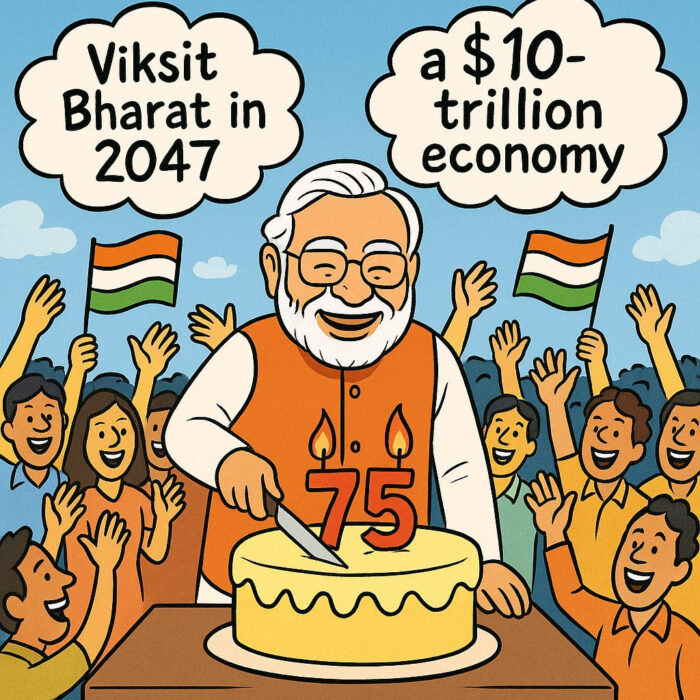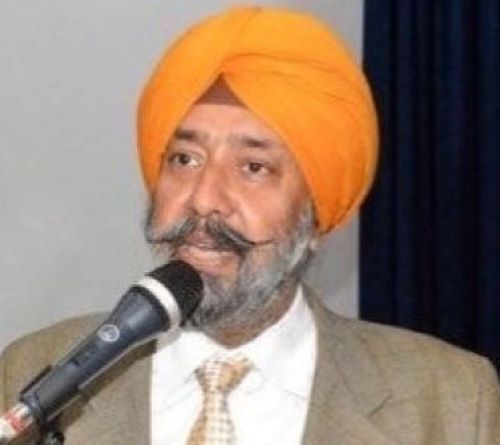 Ten Unfinished Agendas for a United, Strong, Resurgent India (2025–2029)
Ten Unfinished Agendas for a United, Strong, Resurgent India (2025–2029)
I am no Modi bhakt, but I am an admirer of Prime Minister Narendra Modi. What he has achieved, no indecisive Prime Minister or a government suffering from policy paralysis could have achieved. As he turns seventy-five and this Lok Sabha runs its course to May 2029, India stands at a hinge moment. It is tempting to talk of Viksit Bharat in 2047 or a $10-trillion economy sometime in the distant future, but what the country needs now are tangible gains in the next four years—milestones that can be seen, felt and experienced by ordinary citizens. The scaffolding for high growth, strategic autonomy and social mobility is already in place; the next phase must be about finishing the foundations—firmly, fairly and fast. The following ten agendas, in my opinion, focus on outcomes that can be completed or irreversibly set in motion within this term.
1) Productive Jobs through a Manufacturing-and-Services Scale-Up
India’s demographic window will not forgive drift. The centrepiece should be a “National Jobs Compact” that marries a deeper manufacturing push with modern services exports. Prioritise a second wave of Production-Linked Incentives that rewards net domestic value-addition (tooling, components, design) rather than mere assembly; complete the roll-out of the four Labour Codes with phased compliance and hand-holding for MSMEs; and drive a services-export surge in design, gaming, healthcare revenue-cycle management, legal/process outsourcing and fintech. Tie MSME credit guarantees to formalisation milestones and digital invoicing. The finish line to chase is double-digit growth in manufacturing GVA and a step-change in female labour-force participation.
2) Education and Skills: Deliver the NEP in Classrooms, Not Just on Paper
The National Education Policy must translate into teacher quality, foundational literacy and employability. Recruit and empower school leaders; universalise early childhood education through Anganwadi–school convergence; and measure learning outcomes district-wise annually with transparent reporting. In higher education, accelerate multi-disciplinary universities, credit transfer and stackable credentials; link vocational education tightly with apprenticeships and district skill councils. Create a national outcome-fund that rewards states for sustained improvements in Grade-3/5 reading and numeracy and for graduate employability within twelve months.
3) Health and Nutrition: From Insurance Cards to Primary-Care Strength

A resilient India needs a public-health state, not merely a paying state. Upgrade Ayushman Bharat into a primary-care-first model: Health & Wellness Centres with diagnostics, NCD management and telemedicine as default. Establish a national public-health cadre with states; expand disease surveillance and genomic capacity; and fuse nutrition programmes with maternal health and adolescent anaemia elimination. Complement hospital insurance with outcome-based purchasing that rewards quality over volume. Target tangible reductions in out-of-pocket expenditure and measurable declines in stunting and diabetes prevalence.
4) Agriculture Transformation: Income Security while Enabling Diversification
Rural prosperity cannot rest indefinitely on open-ended price guarantees for two cereals. While retaining MSP as a safety net, the Union and states should introduce more attractive, forward-looking packages that make diversification rewarding: expand income support tied to crop diversification; scale up incentive packages for pulses, oilseeds, millets and horticulture; legalise and de-risk land leasing; and strengthen e-NAM with enforceable contracts, logistics support and quality testing. Farmer Producer Organisations should evolve into service companies for inputs, aggregation and branding. The aim is to protect farm incomes while pivoting production towards water-wise, high-value crops.
5) Water Security and Climate Resilience: A Basin-First Compact
Water is India’s binding constraint. Move from scheme-centric interventions to river-basin governance with empowered inter-state councils that plan allocation, quality and flood control together. Extend Atal Bhujal to all critical aquifers with tradable extraction-permit pilots; mandate urban water balance sheets; and institutionalise sponge-city norms for drainage and blue-green infrastructure. A national dashboard for reservoir operations, flood forecasting and dam safety should inform real-time decisions. Climate-proof critical infrastructure corridors against heat, flood and cyclone risks.
6) Energy and Power Sector Reform: Reliability before Rhetoric
A clean transition must keep the lights on and tariffs affordable. Put distribution reform at the centre: loss-reduction compacts with state-wise trajectories, prepaid smart metering that actually bills accurately, and corporate-governance norms for DISCOM boards. Create a deep, liquid market for ancillary services and storage; fast-track transmission projects through transparent, time-bound clearances; and back domestic manufacturing of batteries, electrolysers and power electronics. Plan coal retirement unit-by-unit with just-transition support for affected districts while scaling firm, clean capacity.
7) Renewed Federalism: More Power—and Predictable Money—to States
Co-operative and competitive federalism must be made concrete. Three moves will pay off quickly:
(a) Protect states’ fiscal space by curbing the proliferation of cesses and surcharges outside the divisible pool, and by adopting a medium-term, predictable devolution glide path;
(b) Revamp the GST Council’s decision-making (clear dispute-resolution and time-bound compensation for structural rate changes), while pruning the exempt list and stabilising rate slabs;
(c) Launch a Seventh-Schedule clean-up to rationalise overlaps, moving city transport, urban planning and public health clearly into empowered state/local hands with formula-based grants.
Tie central infrastructure funds to state-level reforms in property-tax buoyancy, town planning, policing and justice delivery. Federalism is not a slogan; it is a financing and functions map.
8) Institutions, Justice and Ease of Living: Make the Law Work on the Ground
Modernised criminal laws and digitised courts will matter only if citizens feel speed and fairness. Commit to a five-pronged sprint: time-bound disposal standards for petty and commercial disputes; all-India e-courts with virtual hearings by default for non-custodial matters; police reforms that separate law-and-order from investigation; modern forensic capacity in every state; and citizen charters with legal consequences for service-delivery delays (land records, registrations, utilities, pensions). Strengthen the independence and competence of regulators (financial, competition, data) with transparent appointments and performance audits. The prize is trust—vital for investment and for everyday dignity.
9) Punjab, Minorities and National Reconciliation: Confidence-Building at the Core
A confident, rising India must carry every community and every border state with it. For Punjab, adopt a “Punjab Prosperity Compact” anchored on four pillars:
Diversification with dignity: A centrally backed, time-bound package to shift from wheat–paddy monoculture to high-value crops, with assured procurement for pulses/oilseeds and targeted risk-sharing for horticulture; strong incentives for micro-irrigation and stubble-management technologies.
Jobs where skills exist: Upgrade Ludhiana–Jalandhar–Mohali industrial clusters to “advanced manufacturing zones” (machine tools, sports goods, medical devices, EV components) with design centres and export logistics.
Health, youth and de-addiction: Treat narcotics as a public-health and national-security challenge—district-level de-addiction and skilling pipelines integrated with community policing and cross-border interdiction.
Heritage and security: Preserve Sikh heritage sites and border gurdwaras; modernise policing and village-level surveillance technologies without burdening civil liberties.
For minorities—especially Sikhs—move from symbolism to substantive empowerment consistent with Articles 29 and 30 of the Constitution (cultural and educational rights). That means: protecting and promoting mother-tongue instruction at the primary level and empowering the Special Officer for Linguistic Minorities (Articles 350A & 350B); expanding scholarships, research chairs and teacher-training pipelines for Punjabi and Sikh studies; supporting minority-run educational institutions to establish and administer their colleges and schools with quality benchmarks and transparent funding; and targeted entrepreneurship credit, skilling and placement programmes. Pair this with evidence-based affirmative support measures available under Articles 15(4), 15(5) and 16(4) for socially and educationally backward classes (including eligible groups within minority communities), alongside focused development in Scheduled Areas under the Fifth/Sixth Schedules read with Article 244 for tribal welfare. The message must be simple: identity is respected, opportunity is equal, justice is swift.
10) Foreign Policy for Strategic Autonomy: Secure the Neighbourhood, Lead in the Indo-Pacific, Compete in Technology
Consolidate a foreign policy that protects borders, stabilises the neighbourhood and expands India’s room for manoeuvre. In the near-abroad, double down on connectivity, energy and disaster-relief compacts that bind South Asia’s economies; keep deterrence steady on the LAC while investing in surveillance, logistics and mountain infrastructure. In the Indo-Pacific, deepen maritime domain awareness, QUAD interoperability and Indian Ocean partnerships, and field credible repair/shipbuilding capacity. Convert the “tech-stack advantage” into statecraft: semiconductor and critical-minerals alliances; trusted-telecom and cloud corridors; cross-border UPI and identity rails; and clean-energy supply chains that reduce import dependence. Pursue high-standard trade pacts where they serve jobs and technology transfer, and push for UNSC and Bretton Woods reform with coalitions of the willing. A confident diaspora policy should be paired with robust consular protection and talent pathways that boomerang skills back to India.
In Summary
These ten agendas—jobs, education, health, agriculture, water, energy, federalism, justice, Punjab & minorities, and foreign policy—are not partisan wish-lists; they are nation-building tasks. They do not demand another 22 years of waiting, nor can they be postponed in the name of distant dreams. They call for visible closure within this very Lok Sabha, by May 2029. If India can achieve clarity in direction, courage in decision-making, and closure in execution over the next four years, then Prime Minister Modi’s legacy at seventy-five will not just be about having led for eleven years, but about having delivered a truly irreversible leap forward. We wish him good health so that he can carry through this compact and cruise India confidently towards 2029.